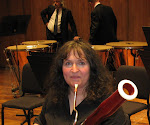Here's all you need to begin learning to circular breathe:
Puff out your cheeks, filling them with air. Then blow into the straw, making bubbles in the water:
When you need a breath, just expel that air from your cheeks into the straw while you simultaneously inhale through your nose. The goal is to sustain the bubbles continuously. If it works, then congratulations - you're circular breathing! (It might help to practice forcing that cheek air out into the straw a few times, creating bubbles in the water by just expelling cheek air, NOT by actually breathing, to get used to the technique.)
That's how I learned to circular breathe. I recall that it was fairly easy to progress to the point where I could sustain constant bubbling. Eventually, when you do this on the bassoon, the goal will be to sustain the flow of air into the bassoon while transitioning from circular to regular breathing. Just keep remembering those bubbles. It's easier to transition with the bubbles in the water than it will be with the air in the bassoon.
The level of difficulty in circular breathing varies from instrument to instrument. I am guessing that it is relatively easy on the clarinet judging by the preponderance of YouTube videos featuring clarinetists circular breathing. Here's an outstanding video of Michael Norsworthy explaining how to circular breathe:
Any bassoonist trying circular breathing on the bassoon for the first time will undoubtedly wonder how the technique could possibly be useful. Intonation goes completely out the window! In fact, because of that, I was very discouraged about my own ability to circular breathe usefully. Now, thanks to the many clarinetists, oboists and didgeridoo players offering instructive videos, I have learned that it often takes years to learn to circular breathe well, so I'm practicing circular breathing again, with renewed enthusiasm. (Summer pops concerts are good for that!)
Is circular breathing necessary? Well, many bassoonists believe that circular breathing is necessary for playing Bach, for example, and circular breathing is actually called for in some contemporary pieces. Decades ago, techniques like flutter tonguing, double tonguing and circular breathing used to be rare parlor tricks. Now they're all necessary aspects of our technique!
My teacher, K. David Van Hoesen presented a recital a few years ago at the IDRS Conference at Ithaca College. I was struck by the incredible ease of his breathing, and how his breathing never once interfered with his graceful phrasing. I mentioned that to him after the recital. Much to my shock, he said that he had circular breathed throughout the performance due to an injury to his ribs from chopping wood. In other words, he played an entire recital by expelling air out with his cheeks while sniffing air through his nose! Any bassoonist who is unsure of the merits of circular breathing should have heard that performance. It was stunning!
.
This is The Record of John
-
Our sermon today used this passage so it was fun to land on this. Orlando
Gibbons: This is the Record of John The Gesualdo Six From the YouTube page:
The G...
7 hours ago








2 comments:
Very interesting! I look forward to trying that technique out!
Good idea with the water. I think I'll try it. You should watch sequenza xii on YouTube. The guy breathes maybe ten times in ten minutes.
Post a Comment